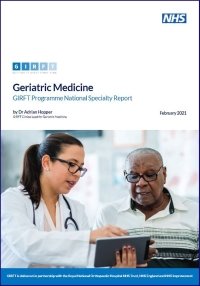The British Geriatrics Society welcomes the new GIRFT (Getting It Right First Time) national report on geriatric medicine. The report identifies unwarranted variation in the provision of geriatric medicine across England and in hospital care for people living with frailty and makes recommendations for improvement.
The report advocates a population-based approach to frailty, where trusts work closely with partners across the system to provide joined-up care and alternatives to hospitalisation, to improve quality of care for older people. Adopting this approach is especially important in light of the COVID-19 pandemic. The report calls for a collaborative approach across whole systems including primary and secondary care, care homes, community services, ambulance services, local authorities and the voluntary sector.
Key recommendations aim to prevent and manage frailty and to provide appropriate community alternatives to hospital if safe and effective care can be offered at home or closer to home. This includes a call for all integrated care systems (ICSs) and sustainability and transformation partnerships (STPs) to develop an integrated frailty system, working across all sectors, offering rapid access to services, support and treatment for people in their own homes where appropriate, and effective pathways for hospital discharge.
The report also contains measures aimed at improving end of life care to help ensure that more older people can be looked after and die in their preferred place of care wherever possible. This is intended to reduce unplanned and avoidable admissions to hospital towards the end of a patient’s life.
Measures recommended in the report have the potential to both improve outcomes for older people across England and to reduce acute care costs for the NHS by up to £687m*, primarily through a reduction in hospital bed days.
- Stronger leadership and training: The report states that some falls, medicine errors, pressure ulcers and infections could be avoided if all trusts appoint a senior member of staff to lead on frailty care, overseeing safety issues, quality of care, staff training and awareness. The report also recommends that all staff caring for older people in hospital or in the community should have basic training to enable them to spot risk factors for frailty.
- Better management of outpatient appointments: The report encourages the further development of online appointments and virtual outpatient clinics, with appropriate support. Where in-person appointments are needed, trusts should aim for a co-ordinated ‘one-stop shop’ approach, so patients have all the appointments they need on the same day wherever possible.
- Avoiding hospital-acquired deconditioning: The report calls for trusts to better identify patients with mild or moderate frailty to prevent them becoming severely frail, providing the support, equipment and facilities they need to get out of bed, dressed and moving each day.
- Improving delirium pathways: Delirium can cause inpatient falls and longer stays in hospital, but some older patients who arrive at hospital are not assessed for the presence of delirium, especially if they arrive out-of-hours or at weekends. The report recommends trusts have a clear pathway for delirium, which includes early identification and assessment, to help improve patient safety.
In addition to improving health outcomes for older people, implementation of the report’s recommendations can reduce costs by decreasing avoidable hospital admissions and outpatient attendances and reducing lengths of stay in hospital. For example, the report shows that if trusts can avoid duplication of new and follow-up outpatient appointments using a ‘one-stop shop’ approach, up to £186m could be saved for the NHS.
President of the BGS, Dr Jennifer Burns, commented:
We warmly welcome this national report and strongly believe implementation of the recommendations has the potential to improve quality of care for older people and can help to realise the ambitions of the Ageing Well programme. We commend the report for acknowledging the importance of professional leadership in developing well co-ordinated, person-centred care across and between primary care, community services, hospitals and care homes.”
Lead author of the report, Dr Adrian Hopper, commented:
Too many older people with frailty suffer needless harms as a result of unplanned hospitalisation, long waits in A&E, long stays, and poor co-ordination of care. Many are approaching the end of life when it is even more important that their needs and wishes should be understood and respected, something which has come into sharp focus during the COVID-19 pandemic. I hope these recommendations can help to build on the enthusiasm and innovation I found among teams and bring about significant improvements, both in the care of our older patients and for the NHS as a whole.”
The GIRFT national report for geriatric medicine is available for everyone working in the speciality to download, even if you do not have an NHS email address. You will need to register for access to this site, but permission is usually granted quickly. Click here to access the report.
*GIRFT reports provide financial opportunity figures to illustrate how improving clinical care will also improve productivity. These figures are calculated after the report’s draft recommendations are finalised, and are not used to inform the report’s findings or the development of the recommendations.
In this report, the opportunities figure includes reductions to length of stay (LoS), planned admissions where no procedure took place, re-operation rates, readmissions, outpatient attendances and follow-ups, and unnecessary procedures and appointments.
Reducing days for older people living with frailty by 30% could result in estimated gross savings of up to £687m. However, realising this opportunity will require significant investment in alternative services.
The report also highlights that demand is rising as the population ages, so the potential financial opportunities identified are relative rather than absolute.
